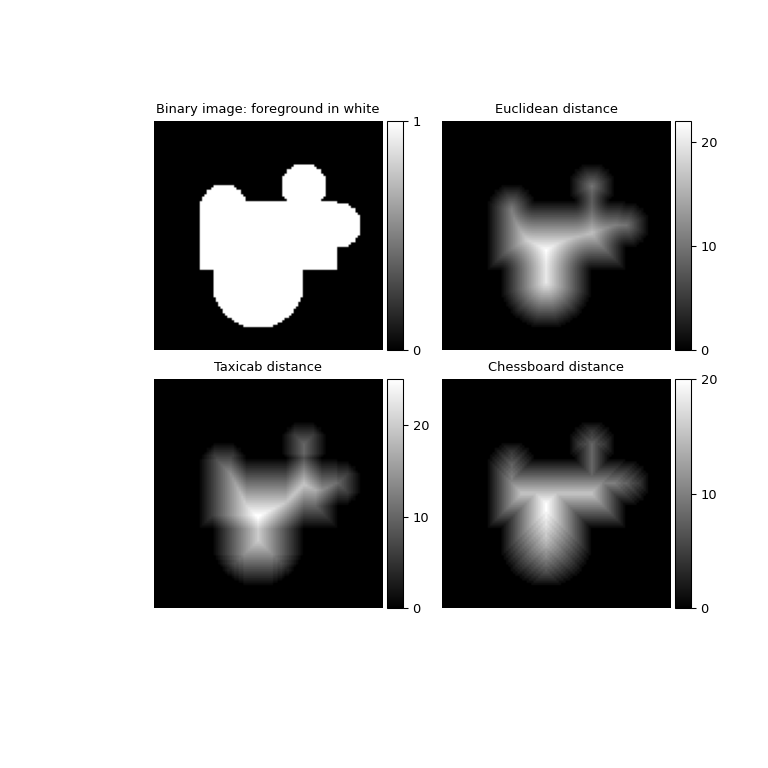distance_transform_bf#
- scipy.ndimage.distance_transform_bf(input, metric='euclidean', sampling=None, return_distances=True, return_indices=False, distances=None, indices=None)[source]#
Distance transform function by a brute force algorithm.
This function calculates the distance transform of the input, by replacing each foreground (non-zero) element, with its shortest distance to the background (any zero-valued element).
In addition to the distance transform, the feature transform can be calculated. In this case the index of the closest background element to each foreground element is returned in a separate array.
- Parameters:
- inputarray_like
Input
- metric{‘euclidean’, ‘taxicab’, ‘chessboard’}, optional
‘cityblock’ and ‘manhattan’ are also valid, and map to ‘taxicab’. The default is ‘euclidean’.
- samplingfloat, or sequence of float, optional
This parameter is only used when metric is ‘euclidean’. Spacing of elements along each dimension. If a sequence, must be of length equal to the input rank; if a single number, this is used for all axes. If not specified, a grid spacing of unity is implied.
- return_distancesbool, optional
Whether to calculate the distance transform. Default is True.
- return_indicesbool, optional
Whether to calculate the feature transform. Default is False.
- distancesndarray, optional
An output array to store the calculated distance transform, instead of returning it. return_distances must be True. It must be the same shape as input, and of type float64 if metric is ‘euclidean’, uint32 otherwise.
- indicesint32 ndarray, optional
An output array to store the calculated feature transform, instead of returning it. return_indicies must be True. Its shape must be
(input.ndim,) + input.shape.
- Returns:
- distancesndarray, optional
The calculated distance transform. Returned only when return_distances is True and distances is not supplied. It will have the same shape as the input array.
- indicesint32 ndarray, optional
The calculated feature transform. It has an input-shaped array for each dimension of the input. See distance_transform_edt documentation for an example. Returned only when return_indices is True and indices is not supplied.
See also
distance_transform_cdtFaster distance transform for taxicab and chessboard metrics
distance_transform_edtFaster distance transform for euclidean metric
Notes
This function employs a slow brute force algorithm. See also the function
distance_transform_cdtfor more efficient taxicab [1] and chessboard algorithms [2].Array API Standard Support
distance_transform_bfhas experimental support for Python Array API Standard compatible backends in addition to NumPy. Please consider testing these features by setting an environment variableSCIPY_ARRAY_API=1and providing CuPy, PyTorch, JAX, or Dask arrays as array arguments. The following combinations of backend and device (or other capability) are supported.Library
CPU
GPU
NumPy
✅
n/a
CuPy
n/a
⛔
PyTorch
✅
⛔
JAX
⚠️ no JIT
⛔
Dask
⚠️ computes graph
n/a
See Support for the array API standard for more information.
References
[1]Taxicab distance. Wikipedia, 2023. https://en.wikipedia.org/wiki/Taxicab_geometry
[2]Chessboard distance. Wikipedia, 2023. https://en.wikipedia.org/wiki/Chebyshev_distance
Examples
Import the necessary modules.
>>> import numpy as np >>> from scipy.ndimage import distance_transform_bf >>> import matplotlib.pyplot as plt >>> from mpl_toolkits.axes_grid1 import ImageGrid
First, we create a toy binary image.
>>> def add_circle(center_x, center_y, radius, image, fillvalue=1): ... # fill circular area with 1 ... xx, yy = np.mgrid[:image.shape[0], :image.shape[1]] ... circle = (xx - center_x) ** 2 + (yy - center_y) ** 2 ... circle_shape = np.sqrt(circle) < radius ... image[circle_shape] = fillvalue ... return image >>> image = np.zeros((100, 100), dtype=np.uint8) >>> image[35:65, 20:80] = 1 >>> image = add_circle(28, 65, 10, image) >>> image = add_circle(37, 30, 10, image) >>> image = add_circle(70, 45, 20, image) >>> image = add_circle(45, 80, 10, image)
Next, we set up the figure.
>>> fig = plt.figure(figsize=(8, 8)) # set up the figure structure >>> grid = ImageGrid(fig, 111, nrows_ncols=(2, 2), axes_pad=(0.4, 0.3), ... label_mode="1", share_all=True, ... cbar_location="right", cbar_mode="each", ... cbar_size="7%", cbar_pad="2%") >>> for ax in grid: ... ax.axis('off') # remove axes from images
The top left image is the original binary image.
>>> binary_image = grid[0].imshow(image, cmap='gray') >>> cbar_binary_image = grid.cbar_axes[0].colorbar(binary_image) >>> cbar_binary_image.set_ticks([0, 1]) >>> grid[0].set_title("Binary image: foreground in white")
The distance transform calculates the distance between foreground pixels and the image background according to a distance metric. Available metrics in
distance_transform_bfare:euclidean(default),taxicabandchessboard. The top right image contains the distance transform based on theeuclideanmetric.>>> distance_transform_euclidean = distance_transform_bf(image) >>> euclidean_transform = grid[1].imshow(distance_transform_euclidean, ... cmap='gray') >>> cbar_euclidean = grid.cbar_axes[1].colorbar(euclidean_transform) >>> colorbar_ticks = [0, 10, 20] >>> cbar_euclidean.set_ticks(colorbar_ticks) >>> grid[1].set_title("Euclidean distance")
The lower left image contains the distance transform using the
taxicabmetric.>>> distance_transform_taxicab = distance_transform_bf(image, ... metric='taxicab') >>> taxicab_transformation = grid[2].imshow(distance_transform_taxicab, ... cmap='gray') >>> cbar_taxicab = grid.cbar_axes[2].colorbar(taxicab_transformation) >>> cbar_taxicab.set_ticks(colorbar_ticks) >>> grid[2].set_title("Taxicab distance")
Finally, the lower right image contains the distance transform using the
chessboardmetric.>>> distance_transform_cb = distance_transform_bf(image, ... metric='chessboard') >>> chessboard_transformation = grid[3].imshow(distance_transform_cb, ... cmap='gray') >>> cbar_taxicab = grid.cbar_axes[3].colorbar(chessboard_transformation) >>> cbar_taxicab.set_ticks(colorbar_ticks) >>> grid[3].set_title("Chessboard distance") >>> plt.show()
